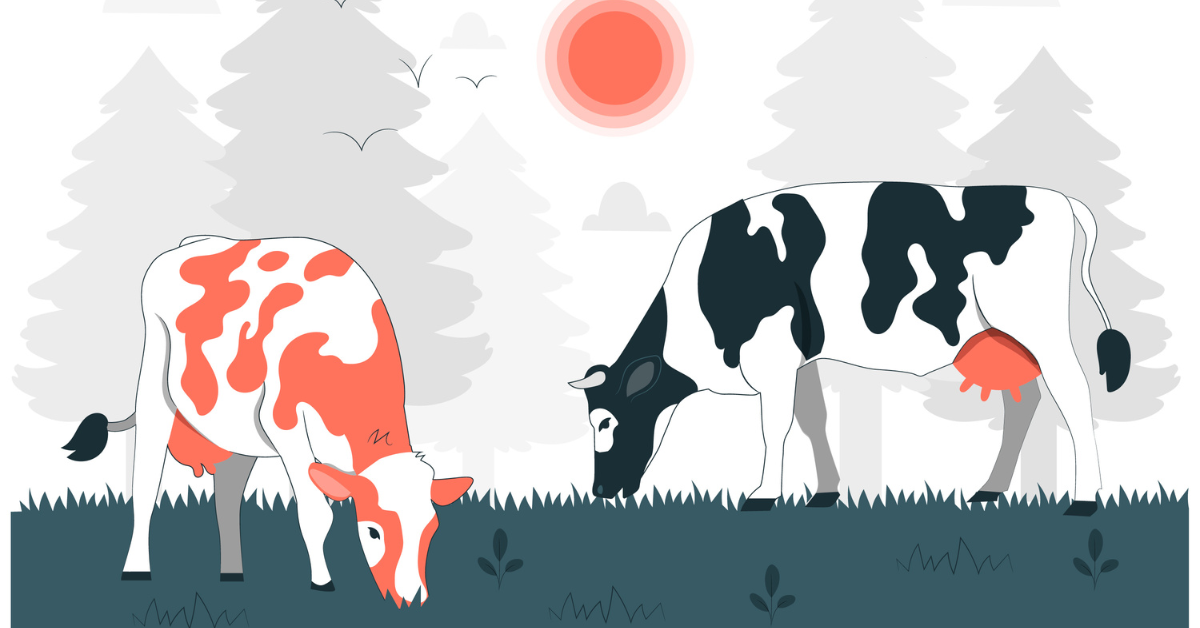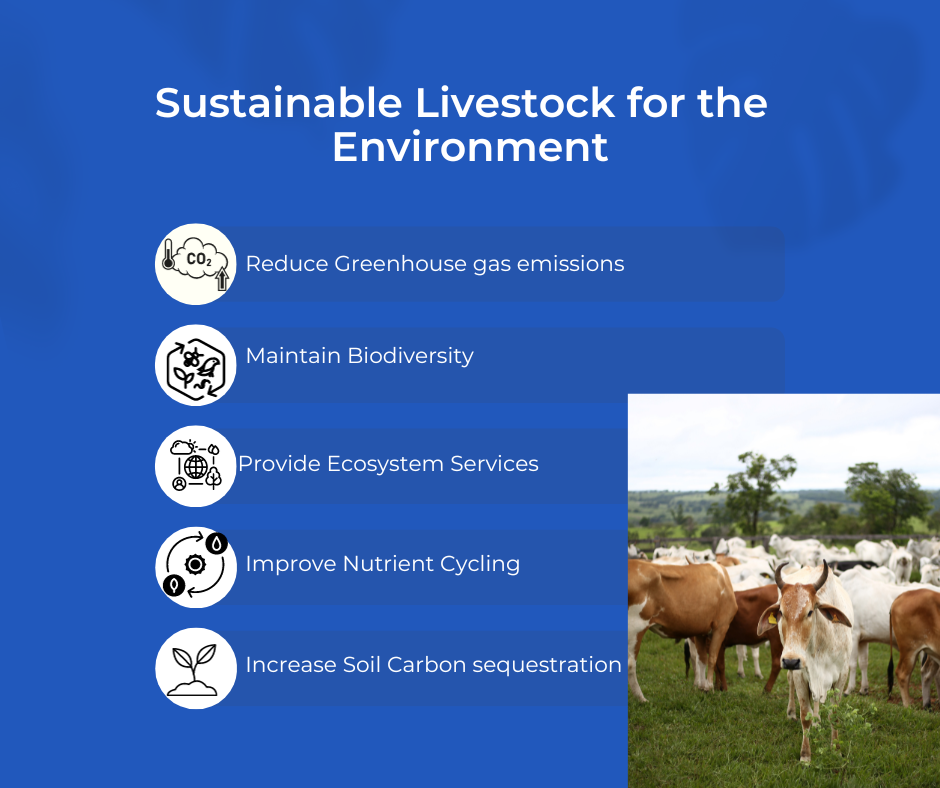Contact: +91 99725 24322 |
Menu
Menu
Quick summary: Discover the importance, benefits, and challenges of sustainable livestock management in our comprehensive blog. Learn how responsible practices can safeguard our environment, support local communities, and ensure a sustainable food supply.

Livestock has been an integral part of human civilization for millenia, providing food, clothing and livelihoods. However, as the global population soars and environmental concerns mount, the way we manage livestock becomes increasingly crucial. Sustainable livestock management is the linchpin that harmonizes the need for animal-based products with ecological well-being.
According to FAO, livestock contributes 40% of the global value of agricultural output and supports the livelihoods and food and nutrition security of almost 1.3 billion people.
In this blog, we delve into the world of sustainable livestock practices, exploring their importance, benefits and innovative approaches that bridge the gap between agriculture and ecology.
Sustainable livestock farming is the management of animals in a way that meets current demands while not jeopardising the ability of future generations to do the same. It places a strong emphasis on sustainable practises, animal welfare, and financial viability. This strategy is essential because it tackles food security, limits resource depletion, lowers greenhouse gas emissions, and supports the ethical treatment of animals—all of which are essential for a healthy planet and balanced ecosystems.
Agriculture productivity and environmental effect must be balanced by increasing food production while reducing environmental damage. To increase yields and safeguard natural resources, this entails putting into practise sustainable farming techniques including crop rotation, precision farming, and minimal chemical use. In order to meet the rising global demand for food while also assuring food security, biodiversity preservation, lowering pollution, and mitigating climate change, this balance must be struck.
According to FAO, the global livestock emissions amount to 7.1 GT of CO2e per year, representing 14.5% of all anthropogenic GHG emissions.
The greenhouse has emissions primarily come from 2 sources:
Enteric Fermentation – Ruminant animals like cows and sheep have stomachs that enables them to digest fibrous plant materials. During this digestion process, microbes in their stomach produce methane, a potent greenhouse gas. This methane is released into the atmosphere through belching.
Manure Management- Livestock generates substantial amounts of manure, when improperly managed can release methane and nitrous oxide, another potent greenhouse gas.
Livestock production is a major driver of deforestation especially in tropical regions. Forests are cleared to create pastureland or to cultivate field crops for animals. Deforestation not only reduces the planet’s capacity to absorb CO2 but also releases stored carbon when trees are cut and burned.
Livestock farming requires vast amounts of land for grazing and growing animal feed. This places pressure on ecosystems, leading to habitat destruction and biodiversity loss.
Livestock energy consumes substantial amounts of water for drinking, cleaning and feed production. Water scarcity and pollution resulting from livestock operations are critical environmental concerns.
Sustainable livestock farming is an approach to raising animals for food production that prioritizes environmental stewardship, social responsibility and economic viability. It aims to meet the current needs for animal-derived products while ensuring long-term health of ecosystems, communities and animal welfare. Sustainable livestock farming involves practices that minimize negative environmental impacts, promote ethical treatment of animals, support local communities and maintain economic profitability for farmers.
Sustainable livestock management practices such as rotational grazing and improved manure management can reduce methane emissions.
Selective breeding and better animal nutrition can enhance the efficiency of livestock farming, reducing the number of animals needed to produce the same amount of meat or dairy.
Certain land management practices like silvopasture ie. Integrating trees and livestock can sequester carbon in soils and vegetation.
The development and promotion of plant-based diets as alternatives to meat and dairy products can reduce the environmental impact of livestock farming.
Selecting and creating plant and animal varieties with desirable qualities including increased yields, disease resistance, and quality are part of improved breeding and genetics. These developments raise sustainability, food security, and agricultural production. Modern biotechnological technologies, like genetic engineering and marker-assisted breeding, are essential for advancing this subject.
In order to produce and use feed sustainably, agriculture must develop and manage feed crops in a way that has the least possible negative impact on the environment. It encourages techniques like organic farming, precision farming, and maximising the utilisation of nutrients in animal diets. These methods contribute to more economically and environmentally sound cattle and poultry farming by reducing resource consumption and waste.
Digital tools, automation, and data-driven strategies are all examples of innovative technologies in cattle management. These developments make it possible to monitor animal behaviour, nutrition, and health in real-time, increasing productivity, decreasing resource waste, and improving animal welfare. IoT sensors, AI-driven analytics, and automated feeding systems are a few examples of how these technologies are revolutionising how we grow and care for animals.
Agriculture that is sustainable in its intensification and diversification aims to boost output and productivity while reducing environmental harm. Crop rotation, agroforestry, and integrated pest control are some of the practises this strategy integrates to increase resilience, save resources, and support biodiversity, providing long-term food security and ecological sustainability.
Sustainable practices help reduce negative environmental impacts of livestock farming such as deforestation, soil erosion and water pollution. This contributes to the preservation of ecosystems and biodiversity.
Sustainable livestock farming aims to reduce methane emissions from animals, a potent greenhouse gas. Implementing practices like improving feeding and waste management can help mitigate climate change.
Sustainable farming includes ethical treatment of animals providing them proper living conditions and humane handling that leads to better animal welfare.
Sustainable practices optimize the use of resources like water and feed, reducing waste and inefficiencies in livestock production.
Sustainable farming can lead to safer and higher quality animal derived products, as animals are healthier and less reliant on antibiotics and other chemicals.
Sustainable livestock farming can enhance the resilience of farming communities by diversifying income sources.
Sustainable practices can improve livelihoods in rural communities, promote equitable access to resources and strengthen the social fabric of farming communities.
Growing consumer awareness of sustainability issues has led to the demand for sustainably produced animal products, providing marketing opportunities for farmers.

Addressing these challenges requires a holistic approach that considers environmental, social and economic aspects while promoting responsible and efficient farming practices.
In conclusion, sustainable livestock management is not merely an option, it’s a necessity for our planet’s health, food security and the well-being of future generations. By adopting practices that minimize environmental impact, prioritize animal welfare and support local communities, we can strike a balance between meeting the global demand for animal products and safeguarding our environment. The challenges are significant, but the benefits, including reduced greenhouse gas emissions, improved resource efficiency and healthier ecosystems, make the effort worthwhile.
